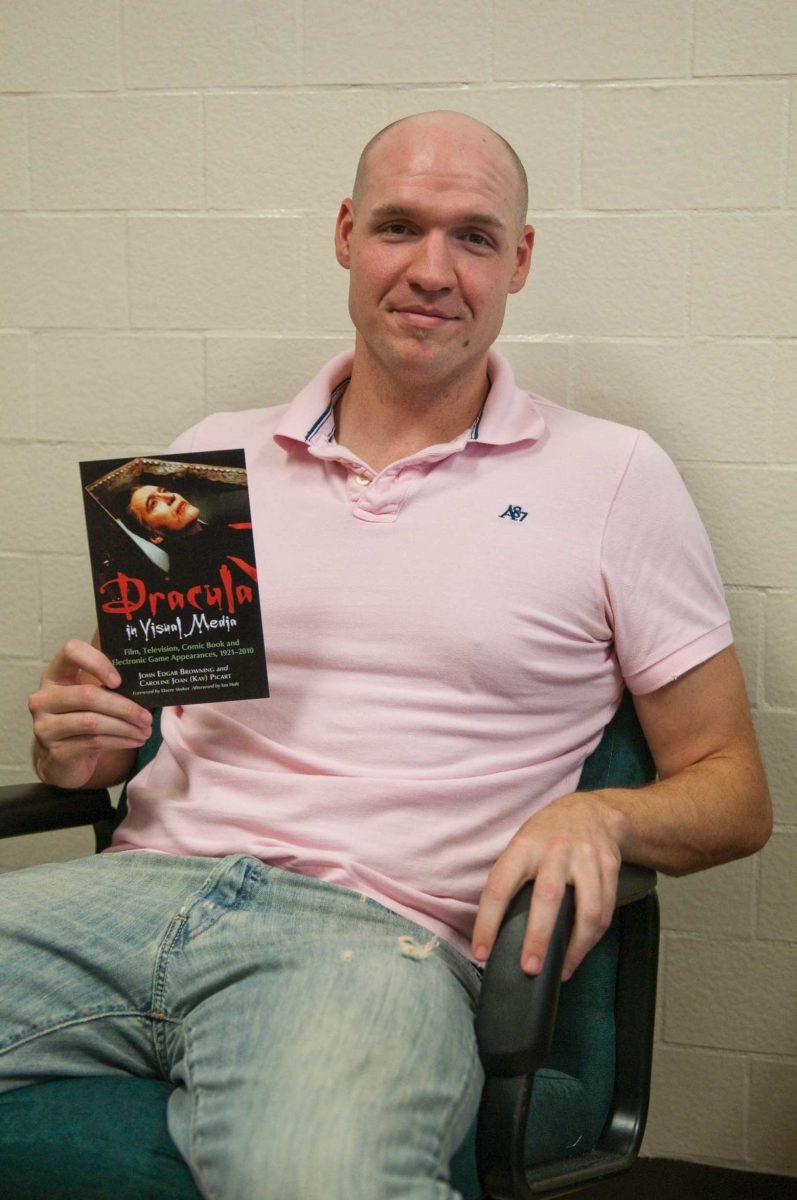John Browning has been watching monsters on the big screen since he was a toddler, and now he’s writing about them.
Browning, an English doctoral candidate and graduate teaching assistant, is expecting his new book, “Dracula in Visual Media,” to be released in mid-November. The book will serve as a Dracula-themed encyclopedia and will be the largest and most comprehensive Dracula sourcebook to date, according to Browning.
“We attempted to catalog every film, documentary, animation, video game, adult feature, television series or episode in which Dracula has appeared from all over the world,” he said. “We’ve got films from every single continent except Antarctica.”
While other vampire source books exist, Browning said none are as extensive as his.
“There were a few books that had attempted to do something similar, but they only got as far as 200 titles,” he said. “We have more than 700.”
Browning’s sourcebook also includes nearly 1,000 comic books and stage adaptations featuring the world’s most famous vampire.
Browning said the idea came from his co-author, Caroline Picart, who had previously published Frankenstein and Holocaust sourcebooks.
“I’m a big Dracula and vampire buff, and I always thought it would be cool to do similar work with Dracula films,” Browning said.
Browning said he didn’t realize how large the project was going to be in the beginning.
“We first contracted the book in 2005, and we had to extend the contract for three years,” he said. “A lot of similar works have catalogued just the domestic crop of films with Dracula or were very Anglo-centric in their scope. In other words, they focused on all the major American and British films, while this book tried to go for everything.”
Much like an encyclopedia, the entries are sectioned by category and listed alphabetically, Browning said. Entries are also listed chronologically in the back of the book, with entries ranging from 1921 to 2010.
“It’s a very research-friendly tool,” he said. “Anyone interested in media history or particularly cultural studies can use this book for that.”
Browning said much can be learned about a culture through its depiction of Dracula.
“If you want to look at what a culture thinks is bad or immoral, just go look at their horror or vampire films. It’s basically a political billboard for how we construct deviance,” he said. “You can trace what’s going with a particular culture and see how that deviance has changed over time.”
Browning said the depiction of vampires has changed over time.
“The Dracula from the ’30s is not nearly the same as the Dracula we see now,” he said. “Dracula has become more and more sexually appealing since the 1930s, and it’s especially common to see studios go for attractive actors.”
Browning said today’s vampires are headed in a more liberal and progressive direction than in previous years, and it has become common for vampires to be considered the good guys, particularly in the popular “Twilight” series.
“‘Twilight’ has a way of convincing people that it’s OK to be a vampire and drink blood as long as you marry the person before you drink their blood,” he said.
Browning said vampire trends are nothing new, and they actually become more popular during economic downturns.
“Studios know that when money’s getting low they can turn to horror films, and they’re going to make money,” he said. “People need outlets, and vampires give that to them.”
But Browning said the difference today is most of the leading vampires aren’t the bad guys.
“Usually people turn to vampire films because they want a Dracula character to hate and vent at, but [today] all the vampires aren’t dying by the end of the film,” he said. “So that’s what’s strange. We are more or less venting on people who would be killing the vampires or maybe this other side of society that is even worse than the vampires.”
Browning, who teaches a class on monster theory and has worked on other published works about monsters and horror, said his interest in monstrosity sparked from his childhood.
“My parents were all about letting my brothers and me watch horror films when we were little,” he said. “A lot of kids growing up talk about how they saw their first horror film when they were like 17 or 18, but mine was when I was like 4.”
But Browning said his passion for the world’s most notorious vampire came from the 1992 film “Bram Stoker’s Dracula.”
“Dracula was pretty low in popularity, but when that film came out he jumped back up. In fact, we’re still riding the spike from the after effects of that film,” he said. “I always liked horror films, and I kind of liked Dracula. But after that film came out, I loved him.”
____
Contact Sarah Eddington at [email protected]
English doctoral candidate writes largest Dracula sourcebook
October 12, 2010




